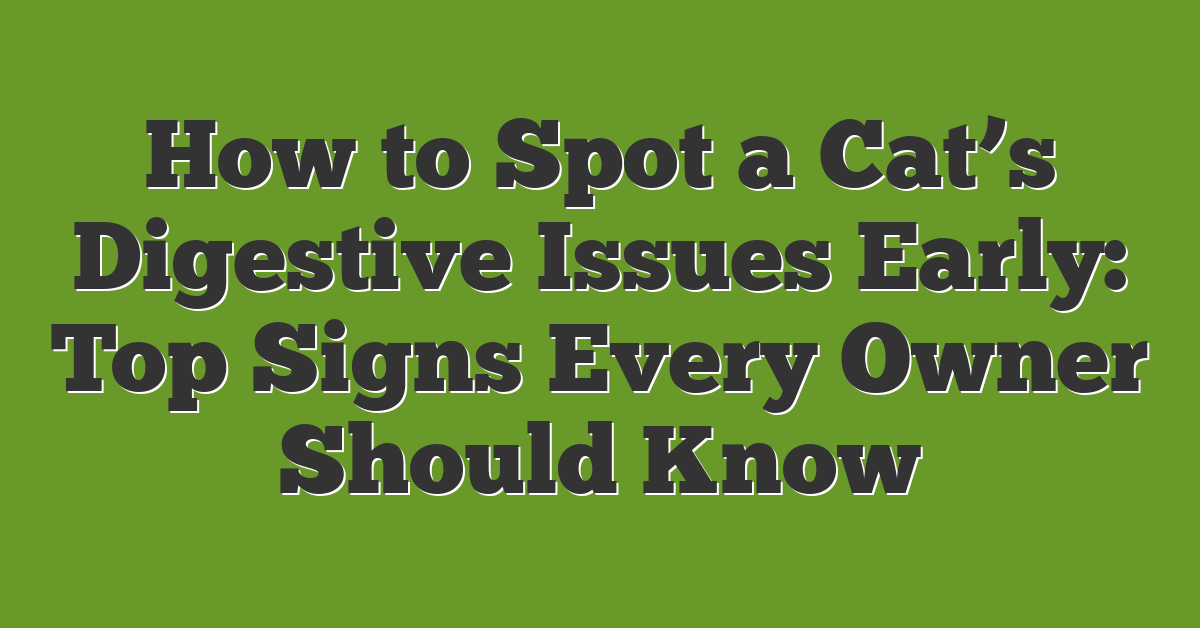Have you noticed your cat acting differently lately? Maybe they’re not eating as much or seem a bit sluggish. These subtle changes could hint at digestive issues that need your attention.

Understanding your cat’s digestive health is crucial for their overall well-being. By learning to spot the early signs, you can address problems before they become serious. From changes in appetite to unusual litter box habits, being observant can make all the difference.
In this guide, you’ll discover the key indicators of digestive distress in cats and learn how to keep your furry friend healthy and happy.
Common Signs of Digestive Problems
Spotting these signs early helps keep your cat healthy. Monitor changes in how your cat eats and eliminates.
Changes in Appetite
A shift in your cat’s appetite can indicate digestive issues. Notice these behaviors:
- Decreased Appetite: Your cat eats less than usual or skips meals.
- Increased Appetite: An unusual hunger may mean your cat isn’t absorbing nutrients properly.
- Food Refusal: Your cat turns away from favorite foods or stops eating altogether.
Vomiting and Diarrhea
- Frequency: Occasional vomiting might not be serious, but repeated episodes need attention.
- Consistency: Watery diarrhea or stool with mucus suggests irritation or infection.
- Presence of Blood: Blood in vomit or stool requires immediate veterinary care.
Behavioral Indicators
Monitoring your cat’s behavior helps you catch digestive issues early. Notice any unusual actions or changes in how your cat acts.
Increased Lethargy
Your cat may seem more tired or less active than usual. If they sleep more and play less, it might indicate discomfort. Lethargy can signal that your cat isn’t feeling well and may have digestive problems.
Hiding or Aggressive Behavior
A healthy cat is usually social, but if your cat starts hiding often or becomes aggressive, it might be struggling. Hiding can mean they’re in pain, while aggression can express discomfort from digestive issues. Pay attention to these changes and consult your vet if you notice them.
Physical Symptoms to Watch For
Noticeable changes in your cat’s body can signal digestive issues. Keep an eye on these physical symptoms to catch problems early.
Weight Loss
Unexpected weight loss shows your cat might have digestive trouble. If your cat eats the same amount but loses weight, it could mean nutrients aren’t absorbed well. Monitor your cat’s weight regularly and consult a vet if you see a drop.
Abdominal Discomfort
Your cat might show signs of abdominal pain. Look for behaviors like squatting, frequent grooming of the belly, or sensitivity when you touch their stomach. Changes in posture or reluctance to move can also indicate discomfort. If you notice these signs, seek veterinary advice promptly.
Diagnostic Approaches
Understanding your cat’s digestive health involves timely action and proper testing. Recognize when professional help is needed and know the available diagnostic options.
When to Consult a Veterinarian
Contact your vet if you notice any of these signs:
- Persistent vomiting or diarrhea: Especially if it lasts more than 24 hours.
- Significant weight loss: Rapid loss can indicate serious issues.
- Lethargy: If your cat seems unusually tired or less active.
- Loss of appetite: Refusing food for more than a day.
- Abdominal pain: Signs include squatting, guarding the belly, or sensitivity when touched.
- Changes in behavior: Hiding, aggression, or other unusual behaviors.
- Blood in stool or vomit: Indicates potential internal problems.
Available Diagnostic Tests
Veterinarians use several tests to diagnose digestive issues:
- Physical Examination: Checks for tenderness, bloating, or abnormalities.
- Blood Tests: Assess organ function and detect infections or inflammation.
- Fecal Analysis: Identifies parasites or bacterial infections.
- X-rays and Ultrasounds: Visualize the abdominal organs for obstructions or abnormalities.
- Endoscopy: Allows direct viewing of the gastrointestinal tract and tissue sampling.
- Biopsy: Collects tissue samples for detailed analysis.
- Allergy Testing: Determines if food allergies contribute to digestive problems.
Prompt diagnosis ensures effective treatment and supports your cat’s health and happiness.
Preventative Measures
Taking steps now helps keep your cat’s digestive system healthy.
Maintaining a Balanced Diet
Provide your cat with high-quality food that meets their nutritional needs. Choose options rich in animal protein, vitamins, and minerals. Avoid sudden changes in their diet to prevent stomach upset. Measure portions to maintain a healthy weight and reduce the risk of digestive issues.
Ensuring Regular Exercise
Keep your cat active with daily play sessions and interactive toys. Regular exercise helps maintain a healthy weight and promotes good digestion. Create an environment with climbing structures and scratching posts to encourage movement. An active cat is less likely to develop obesity-related digestive problems.
Conclusion
Keeping an eye on your cat’s digestive health is key to their happiness and well-being. By staying alert to the signs and addressing any concerns promptly you can ensure your furry friend stays healthy.
Providing a balanced diet and plenty of opportunities for exercise makes a big difference. Your cat relies on you for their health so trust your instincts and don’t hesitate to seek professional advice when needed.
Taking these steps helps maintain your cat’s digestive system and overall quality of life. You’ll enjoy many more joyful moments together knowing you’re supporting their health every day.
















